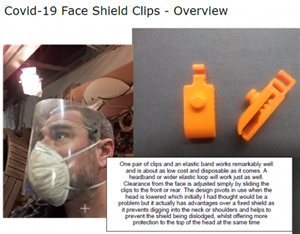The purpose of this document is to provide designers and manufacturers of ventilators with
overarching advice and guidance on the key themes for consideration and specific Human
Factors and Ergonomic (HFE) issues in a period of “crisis management” requiring rapid design
and production.
The authors are mindful that some manufacturers may not have design experience of health care
or the production of ventilators. Wherever possible we have used plain language and provide
illustrative examples of issues to be addressed to “nudge thinking” aimed at creating a safe and
user-friendly product within the current frontline operating context of hospitals

Kenneth Hattersley:
Yes it would indeed be good to get input from viro / biological experts, the motive seems worthwhile.



Hello Mr Phillips.
The use of Ozone for sterilization is new to me but of interest - potentially - for the sterilzation of face masks and other materiel - which has been a topic for a couple of us in this forum..
The premise is that if paper, plastic masks and eyeshields etc - even a proportion - could be recycled back into usage, this could save resources and help make kit available at this time of vast demand.
Using ozone would appear to be relatively low cost to generate and set up a sterilizing environment for smaller objects such as face masks, gowns, etc. using the Ozone Clean type equipment - if it works.
See this and other refs.. Are these trustable though - https://clinmedjournals.org/articles/jide/journal-of-infectious-diseases-and-epidemiology-jide-6-113.php?jid=jide
Would it be possible to ask of the MD what credible evidence there could be that Ozone works on fabrics, plastics (and other materials such as eye masks) with COVID-19? e.g are there any authenticated papers perhaps on neutralizing COVID-SARS -02? And if so what are the specifics however for achieving a sterilization environment - time / concentrations - could it be as simple as running the ozone generator in a chamber with the objects to be cleaned? If it works, what could be the downsides?
Hopefully regards, KenH
Ian Phillips:
Re: COVID-19: Call for rapid sanitising technology for ambulances.
To sanitise all the internal surfaces of an ambulance in significantly less time than 45min, calls for a gaseous solution, and high-levels of Ozone is the natural choice. Ozone is a naturally occurring oxidising gas, which can easily generated as required by using high voltage electricity. It is hazardous to most life-forms including bacteria and viruses and may be generated quite easily inside a confined room such as an ambulance ... and can be neutralised equally quickly for operator safety.
My research quickly lead to this wikipedia page on ozone and this Purozo page discussing the vulnerability of viruses to ozone. And then on to this company Ozone Clean, and its OC1500 Product. And on Sunday this week contacted the MD of the company, who confirmed everything that I hope for about ozone and their product ... including its immediate availability for trials. Ozone Clean is a UK company, the product was designed here and is made in England ... so is potentially readily scaled in production. Further, the MD is prepared to make a machine available immediately for trial.
... Naturally I will pass on the MDs contact details to anybody with serious interest.
This is equipment more usually used by general room cleaners for removing smells in hotel rooms and other public areas ... Indeed NHS is apparently already in possession of some of these, which it no doubt uses in this general cleaning role. But the potential to use this big machine in a smaller confined space to generate high levels of ozone is being overlooked; and repurposing it for sanitising is a very real and immediate possibility!
I realise that this is just a Forum, but I am finding it seriously difficult to talk to anybody about this idea! (I've been working on it for 5 days so far). The IET referred GOV.uk website links to a Defence and Security Accelerator (DASA) which is anticipating a Project Proposal; and the timescale associated with such, is not comparable with the Immediate Possibilities presented by this repurposing of existing equipment.
If any of you could suggest contacts or even champion it I (we) would be most grateful.
Thanks.ian :-)
We're about to take you to the IET registration website. Don't worry though, you'll be sent straight back to the community after completing the registration.
Continue to the IET registration site